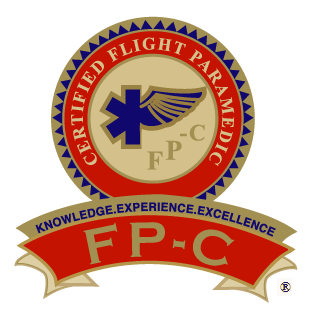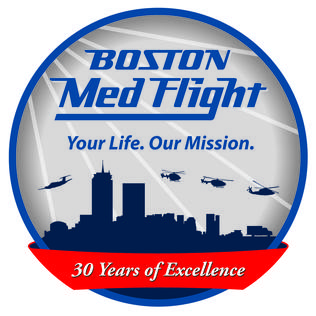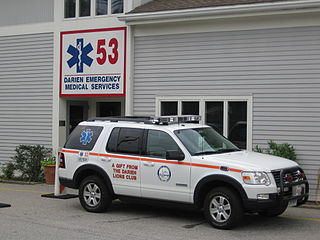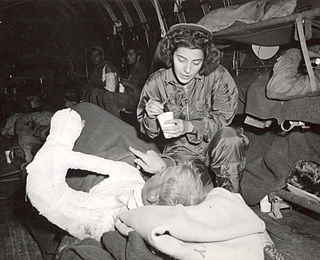
A respiratory therapist is a specialized healthcare practitioner trained in critical care and cardio-pulmonary medicine in order to work therapeutically with people suffering from acute critical conditions, cardiac and pulmonary disease. Respiratory therapists graduate from a college or university with a degree in respiratory therapy and have passed a national board certifying examination. The NBRC is the not-for-profit organization responsible for credentialing the seven areas of Respiratory Therapy in the United States.

Emergency medical services (EMS), also known as ambulance services or paramedic services, are emergency services that provide urgent pre-hospital treatment and stabilisation for serious illness and injuries and transport to definitive care. They may also be known as a first aid squad, FAST squad, emergency squad, ambulance squad, ambulance corps, life squad or by other initialisms such as EMAS or EMARS.

An emergency medical technician (EMT), also known as an ambulance technician, is a health professional that provides emergency medical services. EMTs are most commonly found working in ambulances. In English-speaking countries, paramedics are a separate profession that has additional educational requirements, qualifications, and scope of practice.

A paramedic is a health care professional whose primary role is to provide advanced emergency medical care for critical and emergent patients who access the emergency medical system.

A paramedic is a healthcare professional, providing pre-hospital assessment and medical care to people with acute illnesses or injuries. In Canada, the title paramedic generally refers to those who work on land ambulances or air ambulances providing paramedic services. Paramedics are increasingly being utilized in hospitals, emergency rooms, clinics and community health care services by providing care in collaboration with registered nurses, registered/licensed practical nurses and registered respiratory therapists.

In the United States, the paramedic is a professional whose primary focus is to provide advanced emergency medical care for critical and emergency patients who access Emergency Medical Services (EMS). This individual possesses the complex knowledge and skills necessary to provide patient care and transportation. Paramedics function as part of a comprehensive EMS response, under medical oversight. Paramedics perform interventions with the basic and advanced equipment typically found on an ambulance. The paramedic is a link from the scene into the health care system. One of the eligibility requirements for state certification or licensure requires successful completion of a nationally accredited Paramedic program at the certificate or associate degree level. Each state varies in requirements to practice as a paramedic, and not all states require licensure.

The British Columbia Ambulance Service (BCAS) is an ambulance service that provides emergency medical response for the province of British Columbia, Canada. BCAS is one of the largest provider of emergency medical services in North America. The fleet consists of more than 500 ground ambulances operating from 183 stations across the province along with 80 support vehicles. BCAS provides inter-facility patient transfer services in circumstances where a patient needs to be moved between health care facilities for treatment. BCAS also operates a medical evacuation program that utilizes both fixed-wing and rotary aircraft.

A paramedic in Australia is a health care professional who responds to and treats all types of medical and trauma emergencies outside of a hospital setting before and during transportation to an appropriate medical facility. Paramedics also work in the inter-facility transport environment where a paramedic will continue or upgrade medical care to a higher level while transporting a patient from one healthcare facility to another. Paramedics are able to treat patients in the pre-hospital setting, and can transport them to a hospital-based emergency department if deemed necessary. A new paramedic is evolving, the Paramedic Practitioner. The Paramedic Practitioner provides primary health care in a range of health settings and forms part of a multidisciplinary medical team. In Australia, use of the term paramedic is lawfully restricted to the use of those registered with AHPRA.

The Flight paramedic Certification (FP-C) is an advanced certification that indicates an individual has attained the designation of Certified Flight Paramedic. The FP-C certification exam is administered by the International Board of Specialty Certification (IBSC), a not-for-profit organization responsible for the administration and development of specialty certification exams for critical care professionals. The FP-C exam was the first specialty paramedic certification offered by the Board for Critical Care Transport Paramedic Certification in 2000. This certification is designed for experienced paramedics who have demonstrated advanced knowledge of critical care medicine.
Flight for Life is a prehospital care service with many bases of operation across the United States. Flight for Life is primarily known for its emergency medical helicopter transport, but also operates a fleet of land vehicles and fixed-wing aircraft for the transport of critically ill patients to specialized medical care. Helicopter transport is normally reserved for the most critically injured patients or patients who cannot be reached by traditional means of Emergency medical services. Helicopter transport is also especially useful for the transport of critically wounded patients to specialty medical facilities, such as burn, pediatric, or advanced trauma centers, that may be further away from the location of injury. Many rural communities rely on the speed of the helicopter to reach and evacuate their most serious patients to an available medical center. The helicopter may also be used for search and rescue operations in conjunction with ground units or alone.
Health advocacy or health activism encompasses direct service to the individual or family as well as activities that promote health and access to health care in communities and the larger public. Advocates support and promote the rights of the patient in the health care arena, help build capacity to improve community health and enhance health policy initiatives focused on available, safe and quality care. Health advocates are best suited to address the challenge of patient-centered care in our complex healthcare system. The Institute of Medicine (IOM) defines patient-centered care as: Health care that establishes a partnership among practitioners, patients, and their families to ensure that decisions respect patients’ wants, needs, and preferences and that patients have the education and support they need to make decisions and participate in their own care. Patient-centered care is also one of the overreaching goals of health advocacy, in addition to safer medical systems, and greater patient involvement in healthcare delivery and design.

Boston MedFlight (BMF) is a non-profit organization that provides emergency scene response and emergency interfacility transfer in Eastern Massachusetts at the Critical Care level, which is higher than a paramedic-level ambulance crew's certification, using both aircraft and ground ambulances.

In the United States, emergency medical services (EMS) provide out-of-hospital acute medical care and/or transport to definitive care for those in need. They are regulated at the most basic level by the National Highway Traffic Safety Administration, which sets the minimum standards that all states' EMS providers must meet, and regulated more strictly by individual state governments, which often require higher standards from the services they oversee.

A flight nurse is a registered nurse who specialises in the field of providing comprehensive pre-hospital, emergency critical care, and hospital care to a vast scope of patients. The care of these patients is generally during aeromedical evacuation or rescue operations aboard helicopters, propeller aircraft or jet aircraft. On board a rescue aircraft you would find a flight nurse accompanied by flight medics and respiratory practitioners, as well as the option of a flight physician for comprehensive emergency and critical transport teams. The inclusion of a flight physician is more commonly seen in pediatric and neonatal transport teams. A critical care flight nurse must be able to deal with all age groups with broad critical emergencies. With no physicians on site the nurses scope of practice is expanded. The critical care experience is transferred over to a flight nurse with impacting factors such as altitude and changes in pressure, gravitational forces, and weather. Some patients may experience exacerbation's because of factors related to the cabin environment including hypoxia, limited mobility, gas expansion, and risk of injury related to turbulence and resources with definitive care are limited. Aeromedical evacuation crews coordinate with other organizations to plan for the safe and timely care and evacuation of patients. Crews must be prepared for patients suffering from trauma and mental health illnesses.
Emergency medical services in New Zealand are provided by the Order of St John, except in the Greater Wellington region where Wellington Free Ambulance provides these services. Both have a history of long service to their communities, St John since 1885 and Free beginning in 1927, traditionally having a volunteer base which s day however the vast majority of response work is undertaken by paid career Paramedics. Strategic leadership of the sector is provided by NASO which is a unit within the Ministry of Health responsible for coordinating the purchasing and funding of services on behalf of the Ministry and the Accident Compensation Corporation.

The Queensland Ambulance Service (QAS) is the state emergency ambulance and patient transport provider in Queensland, Australia. QAS is part of the Queensland Government under the Queensland Health portfolio and is one of the largest ambulance services in the world.
Air Evac EMS, Inc., operating as Air Evac Lifeteam, is the largest company within AMGH. Air Evac is still the largest independently owned and operated HEMS, or air ambulance provider. Air Evac currently operates helicopters at 131 bases, covering most of the central and southern states; Service Area. While primarily a HEMS provider, they do operate 2 fixed-wing aircraft in Missouri and Kentucky. Originally based in West Plains, Missouri, the headquarters, dispatch (CenComm), and a few other departments were moved to a new facility in O'Fallon, Missouri in 2013.
Obstetrical nursing, also called perinatal nursing, is a nursing specialty that works with patients who are attempting to become pregnant, are currently pregnant, or have recently delivered. Obstetrical nurses help provide prenatal care and testing, care of patients experiencing pregnancy complications, care during labor and delivery, and care of patients following delivery. Obstetrical nurses work closely with obstetricians, midwives, and nurse practitioners. They also provide supervision of patient care technicians and surgical technologists.
Angels of Flight Canada is a Canadian owned and operated air and ground ambulance service based in Peterborough, Ontario, Canada. It transports patients to and from 104 different countries.

Air medical services is a comprehensive term covering the use of air transportation, aeroplane or helicopter, to move patients to and from healthcare facilities and accident scenes. Personnel provide comprehensive prehospital and emergency and critical care to all types of patients during aeromedical evacuation or rescue operations aboard helicopter and propeller aircraft or jet aircraft.











